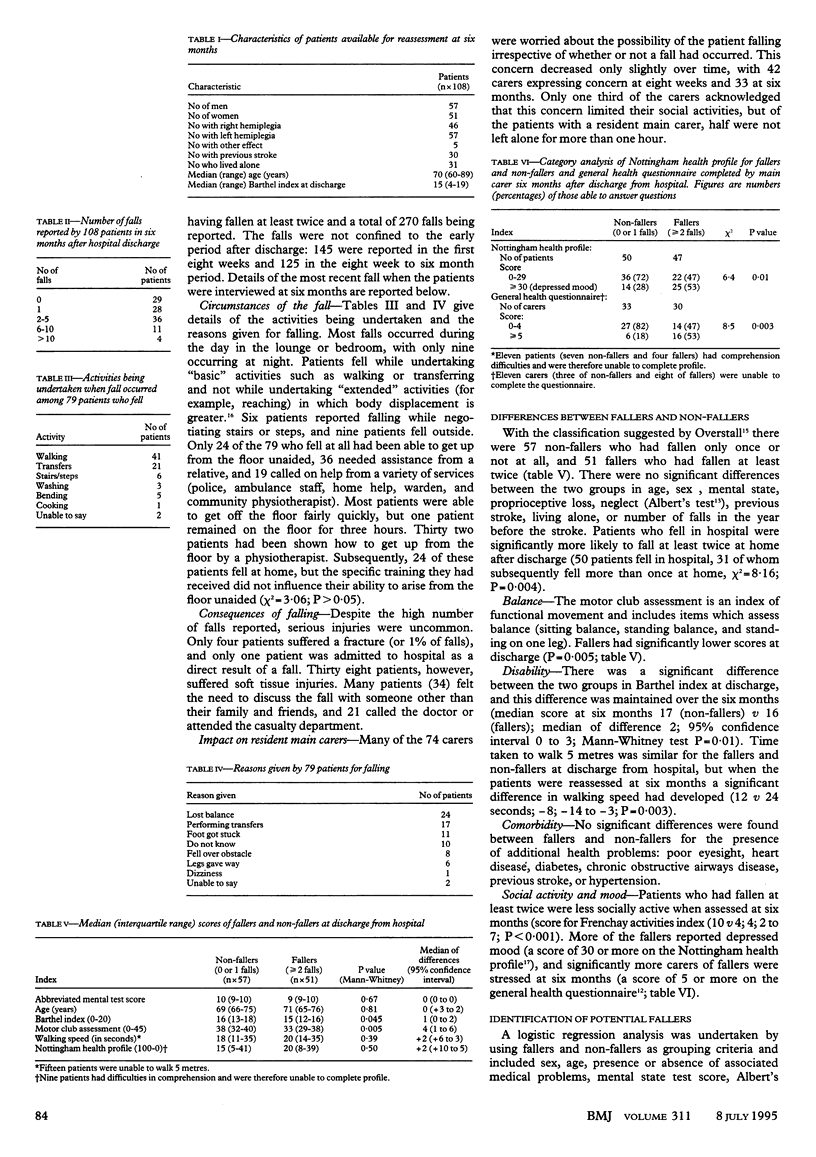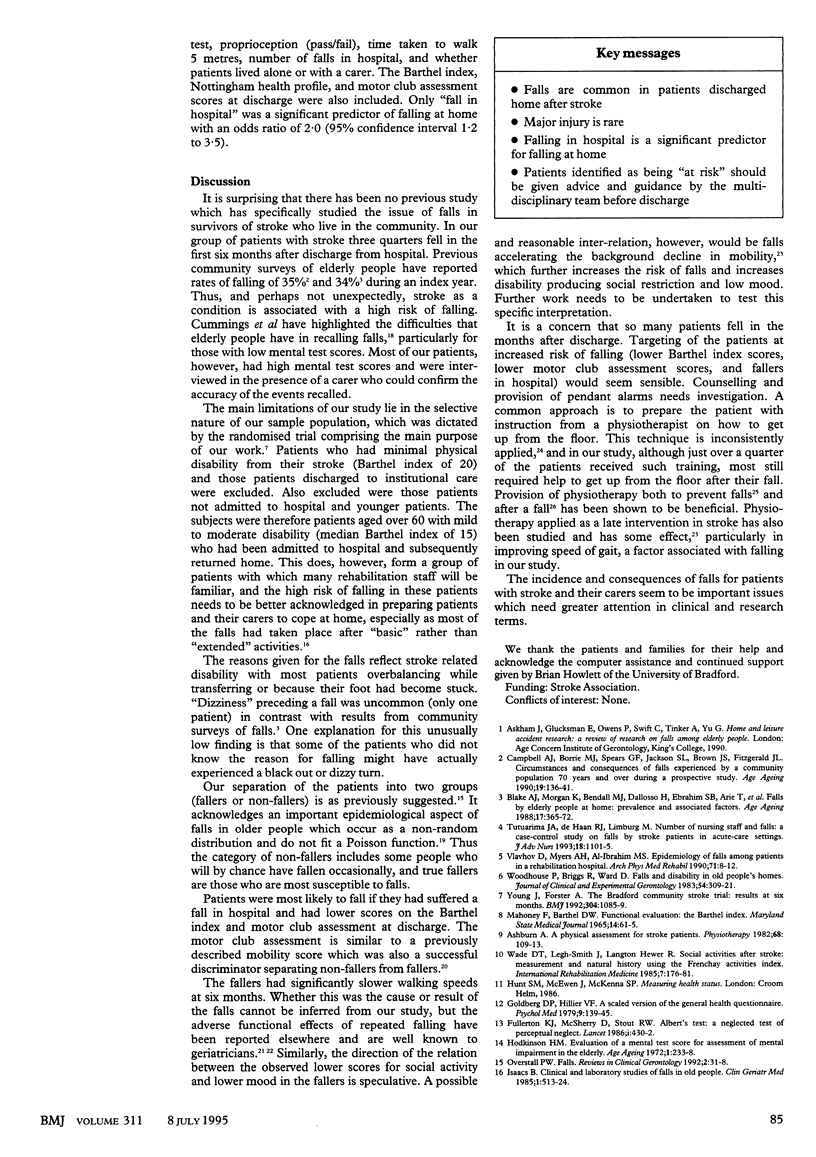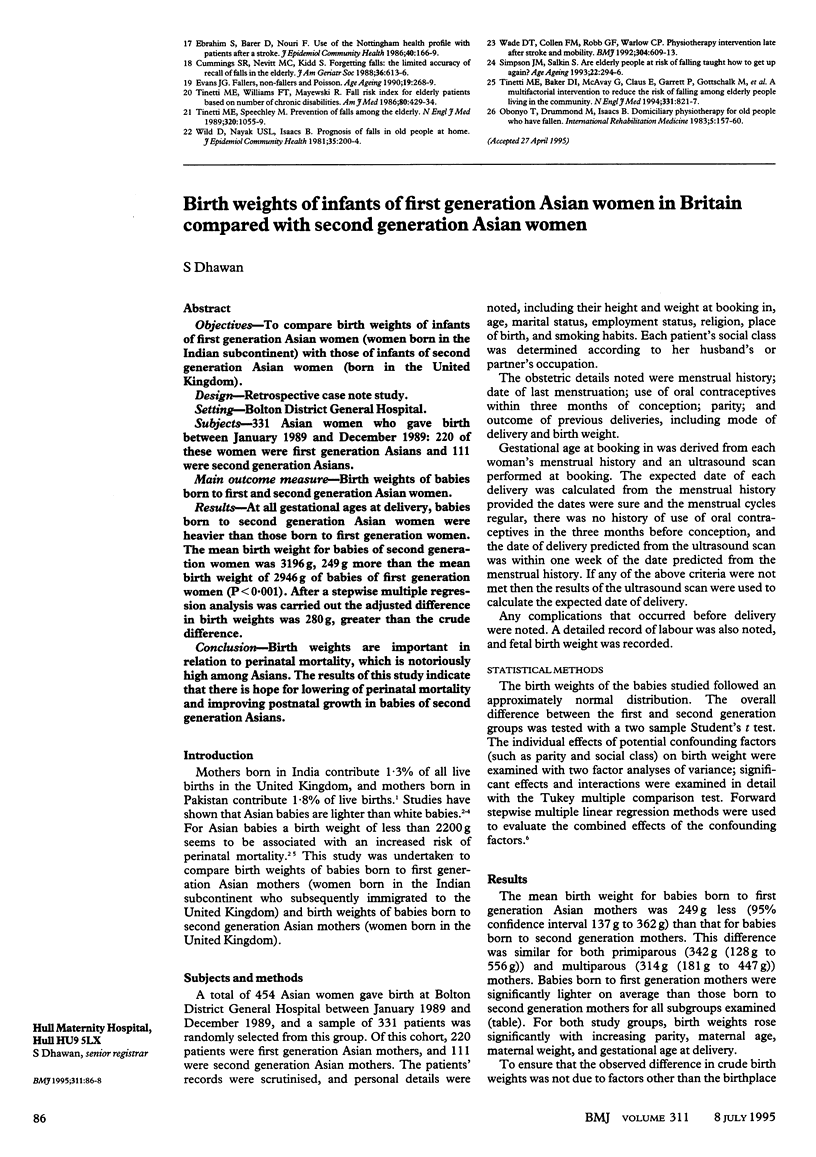Abstract
OBJECTIVE--To undertake a systematic inquiry into the incidence and consequences of falls in a cohort of elderly patients with stroke after discharge from hospital. DESIGN--Administration of a questionnaire to patients and main carers at discharge from hospital and eight weeks and six months later. SETTING--Bradford Metropolitan District. SUBJECTS--108 patients recruited to the Bradford community stroke trial. Patients were recruited to the trial if they were 60 years or over and resident at home with some residual disability. MAIN OUTCOME MEASURES--Number of falls, motor club assessment, Barthel index, Frenchay activities index, and Nottingham health profile. Stress in carers was indicated by the general health questionnaire. RESULTS--Of 108 patients, 79 (73%) fell in the six months after discharge from hospital with a total of 270 falls reported. Patients who fell in hospital were significantly more likely to fall at least twice at home after discharge (chi 2 = 8.16; P = 0.004). "Fallers" (two or more falls) were less socially active at six months and more had depressed mood. Carers of these patients were significantly more stressed at six months (53% v 18%; chi 2 = 8.5; P = 0.003). CONCLUSION--Stroke is associated with a risk of falling at home and affects the lives of patients with stroke and their carers. Falling and fear of falling is an important issue which needs to be dealt with by the multidisciplinary team.
Full text
PDF



Selected References
These references are in PubMed. This may not be the complete list of references from this article.
- Blake A. J., Morgan K., Bendall M. J., Dallosso H., Ebrahim S. B., Arie T. H., Fentem P. H., Bassey E. J. Falls by elderly people at home: prevalence and associated factors. Age Ageing. 1988 Nov;17(6):365–372. doi: 10.1093/ageing/17.6.365. [DOI] [PubMed] [Google Scholar]
- Campbell A. J., Borrie M. J., Spears G. F., Jackson S. L., Brown J. S., Fitzgerald J. L. Circumstances and consequences of falls experienced by a community population 70 years and over during a prospective study. Age Ageing. 1990 Mar;19(2):136–141. doi: 10.1093/ageing/19.2.136. [DOI] [PubMed] [Google Scholar]
- Cummings S. R., Nevitt M. C., Kidd S. Forgetting falls. The limited accuracy of recall of falls in the elderly. J Am Geriatr Soc. 1988 Jul;36(7):613–616. doi: 10.1111/j.1532-5415.1988.tb06155.x. [DOI] [PubMed] [Google Scholar]
- Ebrahim S., Barer D., Nouri F. Use of the Nottingham Health Profile with patients after a stroke. J Epidemiol Community Health. 1986 Jun;40(2):166–169. doi: 10.1136/jech.40.2.166. [DOI] [PMC free article] [PubMed] [Google Scholar]
- Evans J. G. Fallers, non-fallers and Poisson. Age Ageing. 1990 Jul;19(4):268–269. doi: 10.1093/ageing/19.4.268. [DOI] [PubMed] [Google Scholar]
- Goldberg D. P., Hillier V. F. A scaled version of the General Health Questionnaire. Psychol Med. 1979 Feb;9(1):139–145. doi: 10.1017/s0033291700021644. [DOI] [PubMed] [Google Scholar]
- Hodkinson H. M. Evaluation of a mental test score for assessment of mental impairment in the elderly. Age Ageing. 1972 Nov;1(4):233–238. doi: 10.1093/ageing/1.4.233. [DOI] [PubMed] [Google Scholar]
- Isaacs B. Clinical and laboratory studies of falls in old people. Prospects for prevention. Clin Geriatr Med. 1985 Aug;1(3):513–524. [PubMed] [Google Scholar]
- MAHONEY F. I., BARTHEL D. W. FUNCTIONAL EVALUATION: THE BARTHEL INDEX. Md State Med J. 1965 Feb;14:61–65. [PubMed] [Google Scholar]
- Obonyo T., Drummond M., Isaacs B. Domiciliary physiotherapy for old people who have fallen. Int Rehabil Med. 1983;5(4):157–160. doi: 10.3109/03790798309167038. [DOI] [PubMed] [Google Scholar]
- Simpson J. M., Salkin S. Are elderly people at risk of falling taught how to get up again? Age Ageing. 1993 Jul;22(4):294–296. doi: 10.1093/ageing/22.4.294. [DOI] [PubMed] [Google Scholar]
- Tinetti M. E., Baker D. I., McAvay G., Claus E. B., Garrett P., Gottschalk M., Koch M. L., Trainor K., Horwitz R. I. A multifactorial intervention to reduce the risk of falling among elderly people living in the community. N Engl J Med. 1994 Sep 29;331(13):821–827. doi: 10.1056/NEJM199409293311301. [DOI] [PubMed] [Google Scholar]
- Tinetti M. E., Speechley M. Prevention of falls among the elderly. N Engl J Med. 1989 Apr 20;320(16):1055–1059. doi: 10.1056/NEJM198904203201606. [DOI] [PubMed] [Google Scholar]
- Tinetti M. E., Williams T. F., Mayewski R. Fall risk index for elderly patients based on number of chronic disabilities. Am J Med. 1986 Mar;80(3):429–434. doi: 10.1016/0002-9343(86)90717-5. [DOI] [PubMed] [Google Scholar]
- Vlahov D., Myers A. H., al-Ibrahim M. S. Epidemiology of falls among patients in a rehabilitation hospital. Arch Phys Med Rehabil. 1990 Jan;71(1):8–12. [PubMed] [Google Scholar]
- Wade D. T., Collen F. M., Robb G. F., Warlow C. P. Physiotherapy intervention late after stroke and mobility. BMJ. 1992 Mar 7;304(6827):609–613. doi: 10.1136/bmj.304.6827.609. [DOI] [PMC free article] [PubMed] [Google Scholar]
- Wade D. T., Legh-Smith J., Langton Hewer R. Social activities after stroke: measurement and natural history using the Frenchay Activities Index. Int Rehabil Med. 1985;7(4):176–181. doi: 10.3109/03790798509165991. [DOI] [PubMed] [Google Scholar]
- Wild D., Nayak U. S., Isaacs B. Prognosis of falls in old people at home. J Epidemiol Community Health. 1981 Sep;35(3):200–204. doi: 10.1136/jech.35.3.200. [DOI] [PMC free article] [PubMed] [Google Scholar]
- Young J. B., Forster A. The Bradford community stroke trial: results at six months. BMJ. 1992 Apr 25;304(6834):1085–1089. doi: 10.1136/bmj.304.6834.1085. [DOI] [PMC free article] [PubMed] [Google Scholar]


